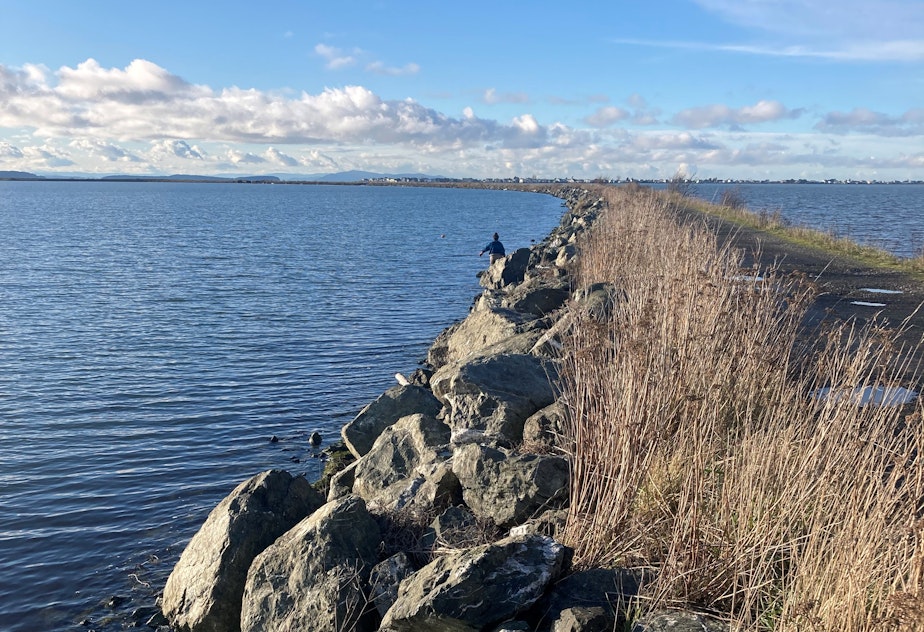Can’t we just eat those invasive crabs until they’re gone? (Probably not)
European green crabs have been clawing and eating their way through marshes and bays in Washington state.
Like the native crabs they often prey on, these destructive invaders are themselves edible. Why don’t we fight them by just eating them into oblivion, KUOW readers and others have asked.
Penn Cove Shellfish general manager Ian Jefferds suggested the state follow up Gov. Jay Inslee’s declaration of a green crab emergency in January by opening up an emergency harvest of the unwanted invertebrates.
“I was thinking about allowing commercial harvest with selective gear in heavily impacted areas,” Jeffords told Washington Department of Fish and Wildlife officials during a recent public meeting on the crabs. “The fishermen could figure it out as they do now.”
Invasive species experts say it’s not so simple.
Trapping teams hauled in more than 100,000 European green crabs in Washington state last year as populations of the cosmopolitan crustaceans exploded in locations including the Lummi Sea Pond on Lummi Bay, Grays Harbor, and Willapa Bay.
Sponsored
Experts say it’ll take much more than that to save eelgrass beds and young Dungeness crabs from these voracious invaders.
Why not harvest green crabs?
The International Union for Conservation of Nature lists green crabs as one of the world’s most destructive invasive species. Humans have wiped out lots of species by overharvesting them, so why not do the same thing with green crabs?
“We hear this an awful lot,” said University of Washington marine biologist Sean McDonald.
Other states invaded by the European crabs, including New Hampshire and Oregon, have tried to generate interest in eating them, but it hasn’t been easy.
Sponsored
“These do not taste as good as our native red rock and Dungeness crabs. They do not get as large,” McDonald said.
The green crabs favor shallow muddy spots that could be difficult for crab boats to reach.
Even if people could be convinced or catch and kill green crabs — by persuasion or even bounties — there’s a good chance they’d kill the wrong ones, according to state wildlife officials.
“The vast majority of reports that we receive, where people think that they found a green crab, it’s not a green crab. It's a native species,” said Allen Pleus with the Washington Department of Fish and Wildlife.
Seemingly successful trapping efforts can backfire, as a study of European green crabs in Bolinas Lagoon in northern California found. Adult green crabs will even eat their own young, and a five-year trapping effort there to remove adult crabs spawned an unexpected population explosion as the young crabs proliferated in the absence of their key predators — their own elders.
Sponsored
“The results of this study provide an urgent warning to those involved in the management of invasive species,” the researchers wrote last year in the Proceedings of the National Academy of Sciences.
Washington state officials say harvesting green crabs is a long-term option, but for now, it’s illegal to possess, sell, or transport them.
On Lummi Bay, the apparent epicenter of Washington’s crab invasion, Lummi Nation officials have permits to catch green crabs, but they report having difficulty finding any productive uses for the tens of thousands of crab carcasses they have hauled in from the 750-acre Lummi Sea Pond. The shallow, sheltered waters of the tribe’s 1970s-era aquaculture facility have proved to be an ideal green crab nursery.
“Most people want the shells or the meat,” said Lummi Nation biologist Bobbie Buzzell. “We really have no way to process them.”
Buzzell said the tribe has found one farmer who expressed interest in turning the carcasses into fertilizer.

No zombie crabs in the NW
Whatever natural forces hold green crabs in check in their native Europe aren’t at play on this continent.
Researchers in California explored controlling the invaders by bringing in one of their worst enemies: an unusual type of barnacle called a rhizocephalan.
Rather than placidly attaching itself to a stationary object as other barnacles do, this barnacle invades the bodies of crabs.
Sponsored
“If you've ever seen the movie Alien with Sigourney Weaver, that's essentially what rhizocephalan barnacles are,” McDonald said. “They're somewhat terrifying until you realize they only affect crabs.”
The barnacle infiltrates a crab’s entire body and controls its behavior, turning it into a sort of zombie crab dedicated to raising the barnacle’s young.
But that’s not all.
“They are a castrating parasite,” McDonald said.
In addition to castrating and killing many green crabs, the barnacles killed all of the native Dungeness crabs they infected in lab experiments at the University of California Santa Barbara.
The Dungeness crab fishery provides 80% of income earned by the Lummi Nation fishing fleet, the state’s largest tribal fishing fleet.
“Of course, we've never explored using this parasite any further,” McDonald said.
While trapping remains the focus of the Washington crab war, Lummi Nation officials are considering other options, including a less-risky type of biocontrol: introducing young Chinook salmon to the crab-infested sea pond from the tribe’s salmon hatchery on the pond to prey on the crab’s tiny larvae.
The Lummi Nation ramped up its green-crab trapping efforts last summer and is gearing up to do much more this year despite supply-chain problems.
The commercial traps the tribe uses to harvest Dungeness crabs are not effective at catching the slightly smaller green crabs. Shrimp traps have been very effective — Lummi technicians deployed them along the perimeter of the sea pond in what they called “the wall of death” — but have been hard to find in large numbers, according to Buzzell.
The tribe’s natural resources department has shifted to buying coated wire mesh from an East Coast supplier in order to build enough homemade traps to make a dent in the crabby invasion of Lummi waters.
Correction 12:20 p.m. 05/23/22: An earlier version of this story misstated the location of Bolinas Lagoon in California.




